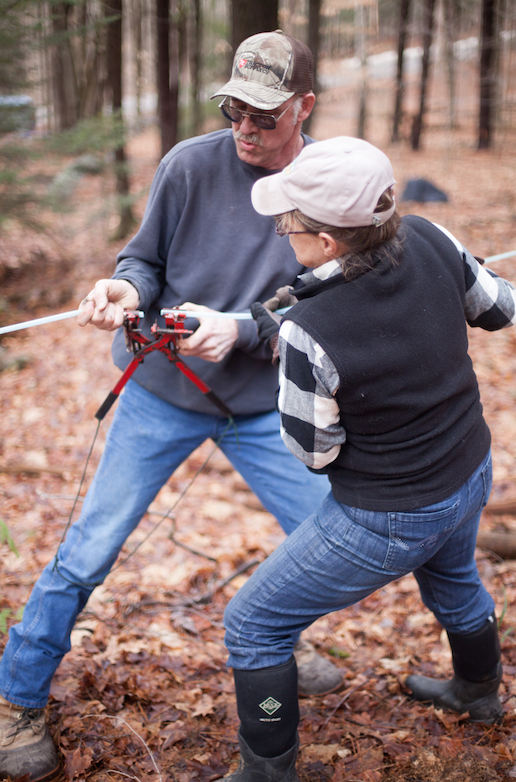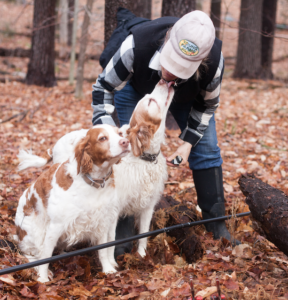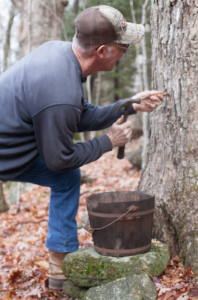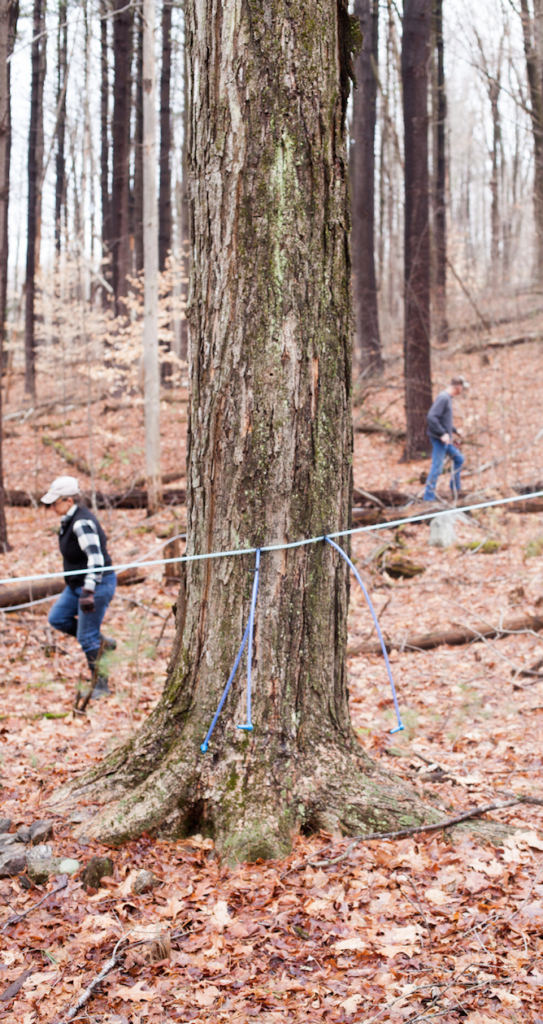 In the frigid months of January and February, when most people are huddled close to woodstoves and fireplaces, Dale and Torrie Young are knee deep in snow wrestling with hundreds of feet of plastic tubing, and smiling from ear to ear. The pair runs Young Farms in East Granby, Connecticut, and the late winter months are for maple sugaring.
In the frigid months of January and February, when most people are huddled close to woodstoves and fireplaces, Dale and Torrie Young are knee deep in snow wrestling with hundreds of feet of plastic tubing, and smiling from ear to ear. The pair runs Young Farms in East Granby, Connecticut, and the late winter months are for maple sugaring.
To call it a job doesn’t quite do it justice—it is more like a calling, bordering on obsession. Dale’s family has been tapping trees since 1925, and Dale and Torrie picked up the tradition in 1979. While the sugaring operation has evolved considerably since the early 1900’s, the final product remains unchanged—New England’s sweetest forest product, maple syrup.
On an unseasonably warm day in January, I joined Dale and Torrie in the woods to learn more about the history of maple sugaring and to see their operation first-hand. We met on NEFF’s Horace Clark Woods, where NEFF leases 25 acres of high-quality sugarbush (a forest with abundant sugar maple trees) to Young Farms. Dale and Torrie pulled up in a minivan filled with tubing, spigots, jerry-rigged tools, and two very excitable Brittany spaniels, Turbo and Pepper.
 After a few quick introductions, we kicked the day off with an experiment. Dale and Torrie had gathered antique tools and implements that were once used to tap trees on the property nearly 100 years ago—a hand-powered drill, a wooden bucket, and a spile (a small wooden tube with tapered, sharpened ends). The duo could hardly hold back their excitement as they tried out the old method. Putting his 6-foot-6-inch frame to use, Dale drilled a two-inch-deep hole in a large sugar maple. As he worked, he described the old process. “The trees have been tapped on this property since the late 30’s that I know of.” Dale said. “On some of the biggest trees along the road and walls you can still see the flat stones that they used to set the buckets on beneath the trunks. At that point, they used oxen for pulling a sled to collect the buckets.”
After a few quick introductions, we kicked the day off with an experiment. Dale and Torrie had gathered antique tools and implements that were once used to tap trees on the property nearly 100 years ago—a hand-powered drill, a wooden bucket, and a spile (a small wooden tube with tapered, sharpened ends). The duo could hardly hold back their excitement as they tried out the old method. Putting his 6-foot-6-inch frame to use, Dale drilled a two-inch-deep hole in a large sugar maple. As he worked, he described the old process. “The trees have been tapped on this property since the late 30’s that I know of.” Dale said. “On some of the biggest trees along the road and walls you can still see the flat stones that they used to set the buckets on beneath the trunks. At that point, they used oxen for pulling a sled to collect the buckets.”
Dale grabbed a hammer and gently tapped the antique spile into the hole. Before Torrie had a chance to set the wooden bucket on a flat stone beneath the tree, the spile started ru
nning with sap. “Holy smokes, that’s pretty cool!” Dale laughed and grinned as sap dripped into the bucket.
 With a successful history lesson under our belts, we headed into the woods to see the sugaring operation. Dale and Torrie use plastic tubing to shuttle sap down the hill—a much more efficient process compared to wooden buckets and oxen-pulled sleds. A network of plastic tubing winds down a long, steep hill from tree to tree, roughly 5 feet off of the ground. Spigots on short segments of tubing branch off of the main lines at each sugar maple large enough for tapping. In the early spring, Dale and Torrie tap the trees and hook up the spigots, running the sap down the hill and into a storage unit.
With a successful history lesson under our belts, we headed into the woods to see the sugaring operation. Dale and Torrie use plastic tubing to shuttle sap down the hill—a much more efficient process compared to wooden buckets and oxen-pulled sleds. A network of plastic tubing winds down a long, steep hill from tree to tree, roughly 5 feet off of the ground. Spigots on short segments of tubing branch off of the main lines at each sugar maple large enough for tapping. In the early spring, Dale and Torrie tap the trees and hook up the spigots, running the sap down the hill and into a storage unit.
While the concept of using tubing seams easy, the job takes hard work, commitment, and attention to detail. During our visit to Clark Woods, Dale and Torrie were repairing damaged tubing and spigots. As they worked, Dale pointed out branches that have fallen on sections of tubing and chew marks left by curious (and pesky) squirrels and porcupines. Dale carried a bucket of spigot replacements, new tubing, and a custom-made gadget that reconnects sections of tubes. Dale and Torrie worked together seamlessly, stretching and pulling the tubing into place to reconnect the network.
“These trees are so awesome—the character of them.” Torrie said while standing next to a massive sugar maple Dale affectionately refers to as a ‘battle axe.’
“We don’t over-tap the trees, because we want them to be here for the next 30 years.” Torrie explained. “Whether we will be here or not, someone will be.”
 Before tapping, Dale and Torrie rigorously inspect the health of each tree, making sure the trees are healthy enough to be tapped. The team stays up-to-date on best practices to ensure that the sugarbush will continue to be healthy and productive.
Before tapping, Dale and Torrie rigorously inspect the health of each tree, making sure the trees are healthy enough to be tapped. The team stays up-to-date on best practices to ensure that the sugarbush will continue to be healthy and productive.
As a supplement to the Clark Woods sugarbush, Dale and Torrie tap what they refer to as ‘ol’ sap cows’ or ‘house trees.’ These trees grow near houses and typically have a large leaf canopy, which produces more sugar during the growing season. While house trees have a higher production rate, they often run at different times than trees in the sugarbush. By tapping house trees and woods trees, Young Farms is able to diversify their sugar production. “Last year, it got too warm in town, and the taps wouldn’t run.” Torrie explained. “We would come up to the woods, and it was running like a bear.”
To wrap up the day, we took a quick drive over to the sugar shack where Dale and Torrie turn raw sap into delicious maple syrup—a process that seems to be part science and part ritual, with a hint of magic.
“We still cook over a wood fire.” Dale explained as he stood next to the heating pans. “A lot of people twenty years ago went to R.O.’s—Reverse Osmosis machines. You run the water into it, and it filters out the concentrate. In my estimation, the syrup doesn’t taste as good as it used to because it isn’t caramelized. We’ve always found that people come to us, and say—hey, your syrup is really, really good!”
Whether it is the trees, the people, or the cooking process, Young Farms maple syrup is officially delicious. In 1997, the North American Maple Syrup Council awarded Young Farm’s maple syrup best in show with a Blue Ribbon award. Each year, Dale and Torrie produce 3 to 4 hundred gallons of this award-winning maple syrup, and it flies off of the shelf. “It’s crazy!” Dale exclaimed. “We never advertise. People just know we have syrup. They’ll come to the door, and I say- that’s the kind of customers you want!”
NEFF History Nugget:
Horace Clark Woods in East Hartland, CT was donated in 1984 by Mrs. Elinor W. Toop in memory of her uncle, Horace B. Clark. Clark founded the Lost Acres Fire Department on June 1, 1936. The barn he built to house the first fire truck still stands on Lost Acres Road, across from Horace Clark Woods. The 427-acre parcel, which is adjacent to the Tunxis State Park, became NEFF’s first Community Forest in Connecticut.
Writing and Photography by Charlie Reinertsen, New England Forestry Foundation’s Communications Manager.


